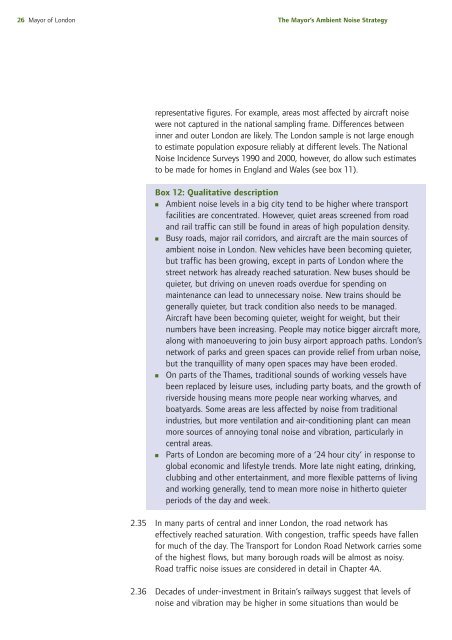The Mayor's Ambient Noise Strategy - Greater London Authority
The Mayor's Ambient Noise Strategy - Greater London Authority
The Mayor's Ambient Noise Strategy - Greater London Authority
Create successful ePaper yourself
Turn your PDF publications into a flip-book with our unique Google optimized e-Paper software.
26 Mayor of <strong>London</strong><br />
<strong>The</strong> Mayor’s <strong>Ambient</strong> <strong>Noise</strong> <strong>Strategy</strong><br />
representative figures. For example, areas most affected by aircraft noise<br />
were not captured in the national sampling frame. Differences between<br />
inner and outer <strong>London</strong> are likely. <strong>The</strong> <strong>London</strong> sample is not large enough<br />
to estimate population exposure reliably at different levels. <strong>The</strong> National<br />
<strong>Noise</strong> Incidence Surveys 1990 and 2000, however, do allow such estimates<br />
to be made for homes in England and Wales (see box 11).<br />
Box 12: Qualitative description<br />
■ <strong>Ambient</strong> noise levels in a big city tend to be higher where transport<br />
facilities are concentrated. However, quiet areas screened from road<br />
and rail traffic can still be found in areas of high population density.<br />
■ Busy roads, major rail corridors, and aircraft are the main sources of<br />
ambient noise in <strong>London</strong>. New vehicles have been becoming quieter,<br />
but traffic has been growing, except in parts of <strong>London</strong> where the<br />
street network has already reached saturation. New buses should be<br />
quieter, but driving on uneven roads overdue for spending on<br />
maintenance can lead to unnecessary noise. New trains should be<br />
generally quieter, but track condition also needs to be managed.<br />
Aircraft have been becoming quieter, weight for weight, but their<br />
numbers have been increasing. People may notice bigger aircraft more,<br />
along with manoeuvering to join busy airport approach paths. <strong>London</strong>’s<br />
network of parks and green spaces can provide relief from urban noise,<br />
but the tranquillity of many open spaces may have been eroded.<br />
■ On parts of the Thames, traditional sounds of working vessels have<br />
been replaced by leisure uses, including party boats, and the growth of<br />
riverside housing means more people near working wharves, and<br />
boatyards. Some areas are less affected by noise from traditional<br />
industries, but more ventilation and air-conditioning plant can mean<br />
more sources of annoying tonal noise and vibration, particularly in<br />
central areas.<br />
■ Parts of <strong>London</strong> are becoming more of a ‘24 hour city’ in response to<br />
global economic and lifestyle trends. More late night eating, drinking,<br />
clubbing and other entertainment, and more flexible patterns of living<br />
and working generally, tend to mean more noise in hitherto quieter<br />
periods of the day and week.<br />
2.35 In many parts of central and inner <strong>London</strong>, the road network has<br />
effectively reached saturation. With congestion, traffic speeds have fallen<br />
for much of the day. <strong>The</strong> Transport for <strong>London</strong> Road Network carries some<br />
of the highest flows, but many borough roads will be almost as noisy.<br />
Road traffic noise issues are considered in detail in Chapter 4A.<br />
2.36 Decades of under-investment in Britain’s railways suggest that levels of<br />
noise and vibration may be higher in some situations than would be
















